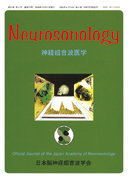Volume 20, Issue 2-3
Displaying 1-9 of 9 articles from this issue
- |<
- <
- 1
- >
- >|
-
2008 Volume 20 Issue 2-3 Pages 74-81
Published: February 01, 2008
Released on J-STAGE: September 07, 2012
Download PDF (4208K) -
2008 Volume 20 Issue 2-3 Pages 82-88
Published: February 01, 2008
Released on J-STAGE: September 07, 2012
Download PDF (1251K) -
2008 Volume 20 Issue 2-3 Pages 89-96
Published: February 01, 2008
Released on J-STAGE: September 07, 2012
Download PDF (8002K)
Atlas of Neurosonology
-
Article type: Atlas of Neurosonology
2008 Volume 20 Issue 2-3 Pages 97-100
Published: February 01, 2008
Released on J-STAGE: September 07, 2012
Download PDF (2265K)
Original Articles
-
Article type: Original Articles
2008 Volume 20 Issue 2-3 Pages 101-104
Published: February 01, 2008
Released on J-STAGE: September 07, 2012
Download PDF (2443K) -
Article type: Original Articles
2008 Volume 20 Issue 2-3 Pages 105-109
Published: February 01, 2008
Released on J-STAGE: September 07, 2012
Download PDF (706K) -
Article type: Original Articles
2008 Volume 20 Issue 2-3 Pages 110-118
Published: February 01, 2008
Released on J-STAGE: September 07, 2012
Download PDF (1821K) -
Article type: Original Articles
2008 Volume 20 Issue 2-3 Pages 119-123
Published: February 01, 2008
Released on J-STAGE: September 07, 2012
Download PDF (764K) -
Article type: Original Articles
2008 Volume 20 Issue 2-3 Pages 124-128
Published: February 01, 2008
Released on J-STAGE: September 07, 2012
Download PDF (4050K)
- |<
- <
- 1
- >
- >|
